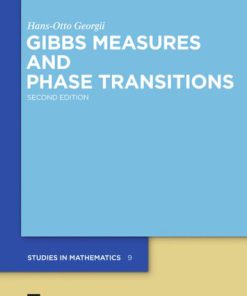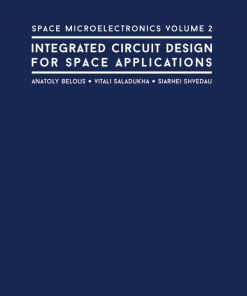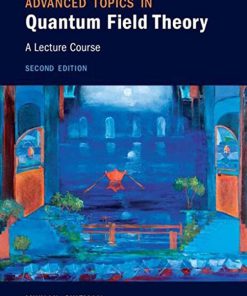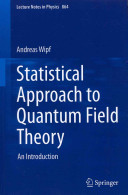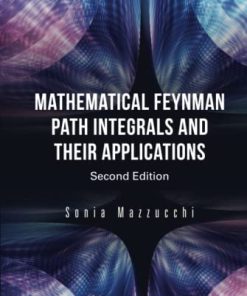Feynman Kac Type Theorems and Gibbs Measures on Path Space 2nd Edition by Fumio Hiroshima, József Lörinczi ISBN 9783110403541 3110403544
$50.00 Original price was: $50.00.$25.00Current price is: $25.00.
Feynman Kac Type Theorems and Gibbs Measures on Path Space 2nd Edition by Fumio Hiroshima, József Lörinczi – Ebook PDF Instant Download/Delivery: 9783110403541 ,3110403544
Full download Feynman Kac Type Theorems and Gibbs Measures on Path Space 2nd Edition after payment
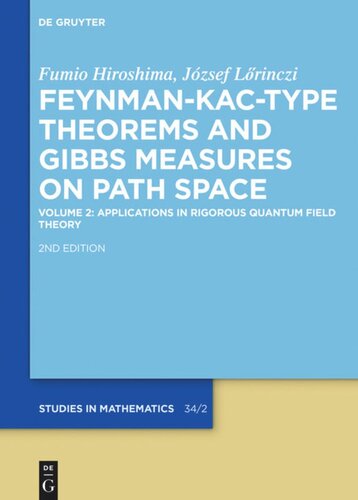
Product details:
ISBN 10: 3110403544
ISBN 13: 9783110403541
Author: Fumio Hiroshima, József Lörinczi
Feynman Kac Type Theorems and Gibbs Measures on Path Space 2nd Edition Table of contents:
I Feynman–Kac-type theorems and Gibbs measures
1 Heuristics and history
1.1 Feynman path integrals and Feynman–Kac formulae
1.2 Plan and scope
2 Probabilistic preliminaries
2.1 An invitation to Brownian motion
2.2 Martingale and Markov properties
2.2.1 Martingale property
2.2.2 Markov property
2.2.3 Feller transition kernels and generators
2.2.4 Conditional Wiener measure
2.3 Basics of stochastic calculus
2.3.1 The classical integral and its extensions
2.3.2 Stochastic integrals
2.3.3 Itô formula
2.3.4 Stochastic differential equations and diffusions
2.3.5 Girsanov theorem and Cameron–Martin formula
2.4 Lévy processes
2.4.1 Lévy process and Lévy–Khintchine formula
2.4.2 Markov property of Lévy processes
2.4.3 Random measures and Lévy–Itô decomposition
2.4.4 Itô formula for semimartingales
2.4.5 Subordinators
2.4.6 Bernstein functions
3 Feynman–Kac formulae
3.1 Schrödinger semigroups
3.1.1 Schrödinger equation and path integral solutions
3.1.2 Linear operators and their spectra
3.1.3 Spectral resolution
3.1.4 Compact operators
3.1.5 Schrödinger operators
3.1.6 Schrödinger operators by quadratic forms
3.1.7 Confining potential and decaying potential
3.1.8 Strongly continuous operator semigroups
3.2 Feynman-Kac formula for external potentials
3.2.1 Bounded smooth external potentials
3.2.2 Derivation through the Trotter product formula
3.3 Feynman-Kac formula for Kato-class potentials
3.3.1 Kato-class potentials
3.3.2 Feynman-Kac formula for Kato-decomposable potentials
3.4 Properties of Schrödinger operators and semigroups
3.4.1 Kernel of the Schrödinger semigroup
3.4.2 Number of eigenfunctions with negative eigenvalues
3.4.3 Positivity improving and uniqueness of ground state
3.4.4 Degenerate ground state and Klauder phenomenon
3.4.5 Exponential decay of the eigenfunctions
3.5 Feynman-Kac-Itô formula for magnetic field
3.5.1 Feynman-Kac-Itô formula
3.5.2 Alternate proof of the Feynman-Kac-Itô formula
3.5.3 Extension to singular external potentials and vector potentials
3.5.4 Kato-class potentials and Lp-Lq boundedness
3.6 Feynman-Kac formula for relativistic Schrödinger operators
3.6.1 Relativistic Schrödinger operator
3.6.2 Relativistic Kato-class potentials and Lp-Lq boundedness
3.7 Feynman-Kac formula for Schrödinger operator with spin
3.7.1 Schrödinger operator with spin
3.7.2 A jump process
3.7.3 Feynman-Kac formula for the jump process
3.7.4 Extension to singular potentials and vector potentials
3.8 Feynman-Kac formula for relativistic Schrödinger operator with spin
3.9 Feynman-Kac formula for unbounded semigroups and Stark effect
3.10 Ground state transform and related diffusions
3.10.1 Ground state transform and the intrinsic semigroup
3.10.2 Feynman-Kac formula for P(f)1-processes
3.10.3 Dirichlet principle
3.10.4 Mehler’s formula
4 Gibbs measures associated with Feynman-Kac semigroups
4.1 Gibbs measures on path space
4.1.1 From Feynman-Kac formulae to Gibbs measures
4.1.2 Definitions and basic facts
4.2 Existence and uniqueness by direct methods
4.2.1 External potentials: existence
4.2.2 Uniqueness
4.2.3 Gibbs measure for pair interaction potentials
4.3 Existence and properties by cluster expansion
4.3.1 Cluster representation
4.3.2 Basic estimates and convergence of cluster expansion
4.3.3 Further properties of the Gibbs measure
4.4 Gibbs measures with no external potential
4.4.1 Gibbs measure
4.4.2 Diffusive behaviour
II Rigorous quantumfield theory
5 Free Euclidean quantum field and Ornstein–Uhlenbeck processes
5.1 Background
5.2 Boson Fock space
5.2.1 Second quantization
5.2.2 Segal fields
5.2.3 Wick product
5.3 ℒ -spaces
5.3.1 Gaussian random processes
5.3.2 Wiener–Itô–Segal isomorphism
5.3.3 Lorentz covariant quantum fields
5.4 Existence of ℒ -spaces
5.4.1 Countable product spaces
5.4.2 Bochner theorem and Minlos theorem
5.5 Functional integration representation of Euclidean quantum fields
5.5.1 Basic results in Euclidean quantum field theory
5.5.2 Markov property of projections
5.5.3 Feynman–Kac–Nelson formula
5.6 Infinite dimensional Ornstein–Uhlenbeck process
5.6.1 Abstract theory of measures on Hilbert spaces
5.6.2 Fock space as a function space
5.6.3 Infinite dimensional Ornstein–Uhlenbeck-process
5.6.4 Markov property
5.6.5 Regular conditional Gaussian probability measures
5.6.6 Feynman–Kac–Nelson formula by path measures
6 The Nelson model by path measures 293 6.1 Preliminaries
6.2 The Nelson model in Fock space
6.2.1 Definition
6.2.2 Infrared and ultraviolet divergences
6.2.3 Embedded eigenvalues
6.3 The Nelson model in function space
6.4 Existence and uniqueness of the ground state
6.5 Ground state expectations
6.5.1 General theorems
6.5.2 Spatial decay of the ground state
6.5.3 Ground state expectation for second quantized operators
6.5.4 Ground state expectation for field operators
6.6 The translation invariant Nelson model
6.7 Infrared divergence
6.8 Ultraviolet divergence
6.8.1 Energy renormalization
6.8.2 Regularized interaction
6.8.3 Removal of the ultraviolet cutoff
6.8.4 Weak coupling limit and removal of ultraviolet cutoff
7 The Pauli–Fierz model by path measures
7.1 Preliminaries
7.1.1 Introduction
7.1.2 Lagrangian QED
7.1.3 Classical variant of non-relativistic QED
7.2 The Pauli–Fierz model in non-relativistic QED
7.2.1 The Pauli–Fierz model in Fock space
7.2.2 The Pauli–Fierz model in function space
7.2.3 Markov property
7.3 Functional integral representation for the Pauli–Fierz Hamiltonian
7.3.1 Hilbert space-valued stochastic integrals
7.3.2 Functional integral representation
7.3.3 Extension to general external potential
7.4 Applications of functional integral representations
7.4.1 Self-adjointness of the Pauli–Fierz Hamiltonian
7.4.2 Positivity improving and uniqueness of the ground state
7.4.3 Spatial decay of the ground state
7.5 The Pauli–Fierz model with Kato class potential
7.6 Translation invariant Pauli–Fierz model
7.7 Path measure associated with the ground state
7.7.1 Path measures with double stochastic integrals
7.7.2 Expression in terms of iterated stochastic integrals
7.7.3 Weak convergence of path measures
7.8 Relativistic Pauli–Fierz model
7.8.1 Definition
7.8.2 Functional integral representation
7.8.3 Translation invariant case
7.9 The Pauli–Fierz model with spin
7.9.1 Definition
7.9.2 Symmetry and polarization
7.9.3 Functional integral representation
7.9.4 Spin-boson model
7.9.5 Translation invariant case
8 Notes and References
Bibliography
Index
People also search for Feynman Kac Type Theorems and Gibbs Measures on Path Space 2nd Edition:
feynman kac proof
feynman-kac formula proof
feynman–kac formula
feynman-kac-type theorems and gibbs measures on path space
feynman-kac formula explained
Tags: Fumio Hiroshima, József Lörinczi, Kac Type, Theorems, Gibbs Measures, Path Space
You may also like…
Uncategorized
Physics - Theoretical Physics
Advanced Topics in Quantum Field Theory 2nd Edition by Mikhail Shifman ISBN 9781108840422 1108840426
Physics - Quantum Physics
Quantum Field Theory 2nd Edition by Michael Sadovskii 3110645157 9783110645156
Physics - Quantum Physics
Relativistic Quantum Field Theory 1st Edition by Michael Strickland ISBN 9780750330213 075033021X
Mathematics - Mathematical Physics
Mathematical Feynman Path Integrals And Their Applications second Edition Sonia Mazzucchi



